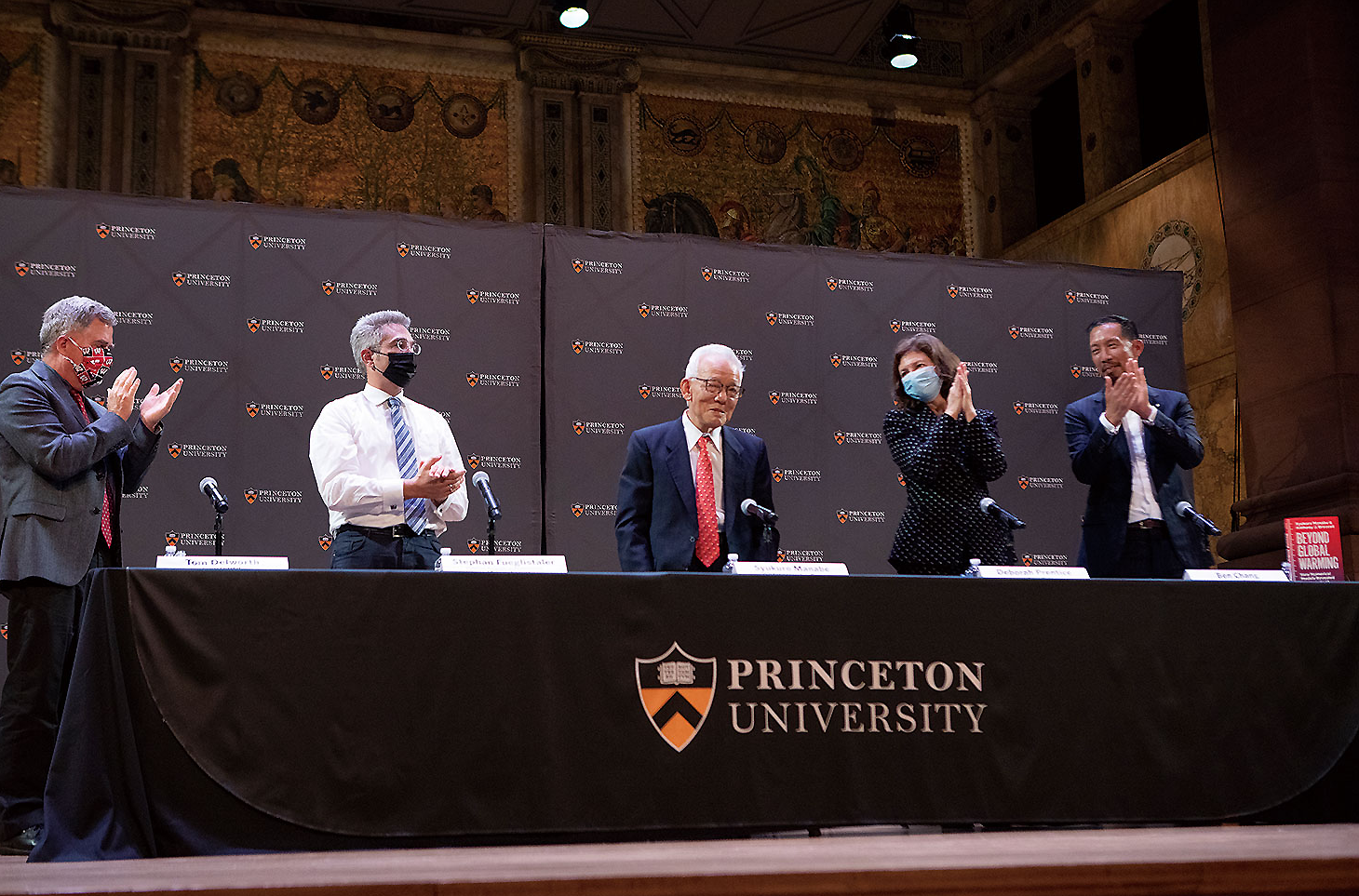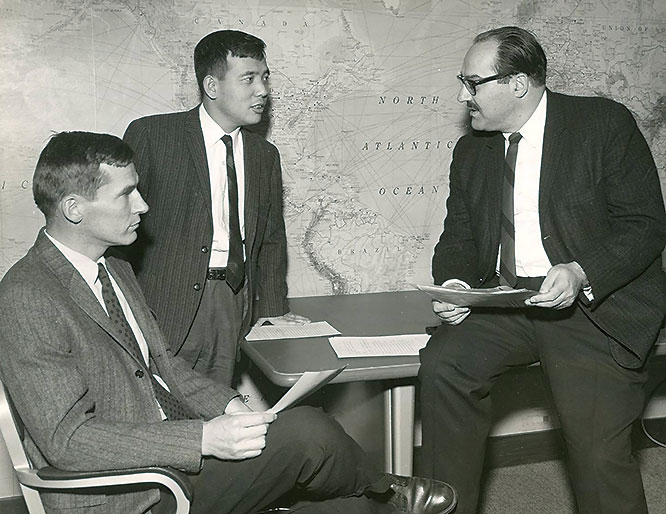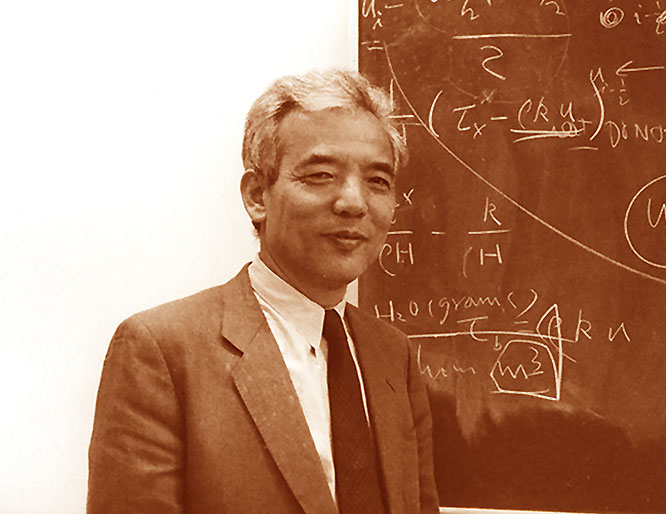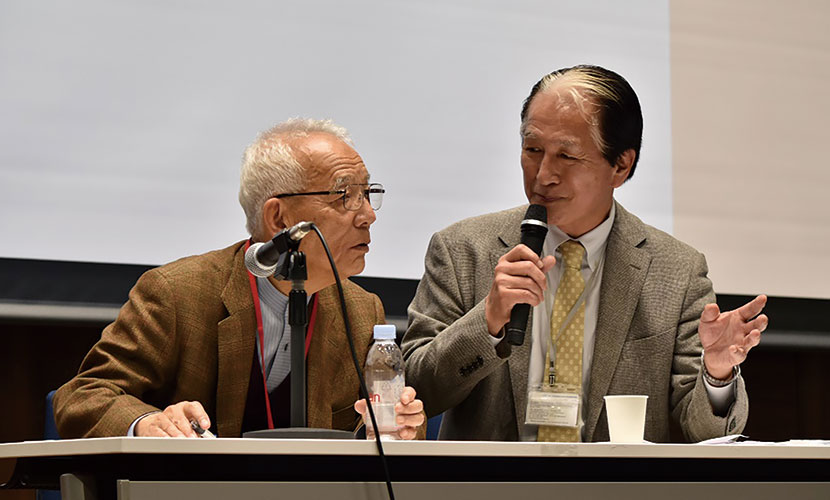Disclaimer: machine translated by DeepL which may contain errors.
Nobel Prize in Physics 2021 awarded to Dr. Yoshiro Manabe

Photo by Denise Applewhite, Princeton University, Office of Communications (2021)
| Dr. Yoshiro Manabe, Ph. |
| D. in Geophysics from the Department of Physics* , Faculty of Science, The University of Tokyo in 1953. D. in 1958 from the University of Tokyo. After working at the U.S. Weather Bureau (1958) and the U.S. National Oceanic and Atmospheric Administration's Geophysical Fluid Dynamics Institute (1963), he became a Visiting Professor and Lecturer in the Atmosphere and Ocean Research Program at Princeton University in 1968 (until 1997). He has been a Visiting Professor at the Faculty of Science, The University of Tokyo, and Director of the Frontier Research System for Global Change since 2005, and will be awarded the Nobel Prize in Physics in 2021. * Reference ": The University of Tokyo Centennial History, Faculties, Graduate Schools, and Institutes" (researched by the Editorial Board of Faculty of Science News) |
Dr . Yoshiro Manabe will be awarded the Nobel Prize in Physics in 2021.
Masahiro Hoshino ( Graduate School of Science , School of Science, Head of Department / Professor, Department of Earth and Planetary Science)
Dr. Yoshiro Manabe will be awarded the 2021 Nobel Prize in Physics. I would like to extend my heartfelt congratulations to him. Dr. Manabe graduated from the Faculty of Science at The University of Tokyo in 1953 and received his Ph. Immediately after that, he moved to the U.S., where he worked tirelessly on climate research using computer simulations at the U.S. Atmosphere and Ocean Research Institute. At that time, computers were in their infancy and it was becoming possible to handle complex phenomena by numerical simulation. Dr. Manabe was the first in the world to develop a model that combined an atmospheric general circulation model with an ocean general circulation model, making full use of computer simulations, and he has conducted a number of pioneering studies, in particular, clarifying the impact of increases in atmospheric carbon dioxide concentration on global warming.
The reason for the Nobel Prize this time is "the prediction of global warming by modeling the global climate system as a complex system. With global environmental issues becoming a major challenge for human society, it is significant that the results of his research on climate model development have been highly acclaimed. Dr. Manabe also actively mentored younger researchers, serving as Visiting Professor at Princeton University and Director of the Global Warming Prediction Research Area of the Frontier Research System for Global Change, a joint project of the National Space Development Agency of Japan (NASDA) and the Japan Marine Science and Technology Center (JAMSTEC). We would like to extend our sincere congratulations to a senior student of the Graduate School of Science, The University of Tokyo, for receiving this award.
Congratulations to Dr. Yoshiro Manabe for winning the Nobel Prize
Eiichi Tajika ( Head of Department of Earth and Planetary Science / Professor, Department of Earth and Planetary Science)
It has been decided that Dr. Yoshiro Manabe will be awarded the Nobel Prize in Physics. On behalf of the Department of Earth and Planetary Science, I would like to extend our congratulations. It is rare that the Nobel Prize in Physics has been awarded to a researcher in the field of geophysics, and this is the first time that it has been awarded to a researcher in meteorology/climatology, so this is unexpected and very exciting news.
Dr. Manabe is truly a pioneer in global warming research, having pioneered research on the effects of atmospheric carbon dioxide on the greenhouse effect in the 1960s, long before global warming became an issue. D. degree in 1958 from the Department of Earth and Planetary Physics and the Department of Earth and Planetary Science, the predecessor of the current Department of Physics and Department of Planetary Science, and the Graduate School of Mathematics and Geophysics. All of us in the Department are very happy and proud that the first Nobel laureate has come from our Department.
I would like to extend my heartfelt congratulations to Dr. Manabe on receiving the Nobel Prize.
Dr. Manabe and Climate Research
Junko Masumoto, Professor, Department of Earth and Planetary Science
Like a child full of curiosity. It is very rude to be so rude to Dr. Manabe, who is a senior professor, but this is the impression I had when I first met him, whom I had known only through his papers for a long time, and I am sure many of you will agree with me. However, in researching how the Earth's climate is determined and how it is changing, it is impossible to go on without reading Dr. Manabe's papers, and he is a giant in the field of climate research. The news that Dr. Manabe has been awarded the Nobel Prize in Physics has been circulating around the world. I would like to extend my heartfelt congratulations to Dr. Manabe on receiving this award.
Dr. Manabe has developed a physical model of radiative-convective equilibrium, which is important in considering the Earth's climate, and has used a computer-based numerical model to clarify how the input of solar radiation energy to the Earth's atmosphere, where various radiation absorbing gases exist, causes temperature distributions and how the radiation absorbing gases affect these distributions. The numerical modeling is based on computer simulations. We have developed from a vertical one-dimensional atmospheric model to a three-dimensional climate model that couples the atmosphere and oceans, quantifying climate variability and change and establishing a foundation for reliable global warming prediction. Through his research, he has made significant contributions to our understanding of the physics of climate, which is considered to be a representative example of a complex system.
Looking at Dr. Manabe's research to date, we can see that he has maintained a style of thinking and modeling complex phenomena as simply as possible while preserving the essence of the phenomena. This is exactly what physics aims for. I cannot help but be amazed at the fact that he has maintained a keen eye for the essence and is still actively engaged in research. I do not know if it was by chance or necessity, but perhaps we were fortunate that our interests were focused on the Earth's atmosphere and oceans, which can be considered ultra-complex systems, and the climate they interweave. The period from the late 1950s to the 1960s, when Dr. Manabe began his research, was a time of great progress in the construction of numerical models of the atmosphere and oceans and in numerical methods, and it can be said that his curiosity and physical sense intersected at the right time with the great swell of the times. He has conducted pioneering research in predictive science looking toward the future of global warming as one of the mechanisms of climate change, but he has also turned his interest to the past and has made many accomplishments in paleoclimate research. I will never forget the shock I felt when I read his paper showing that, even under the same boundary conditions, the meridional circulation reaching from the surface to the depths of the global ocean can be realistic or extremely weakened depending on the initial conditions, and that this has a significant impact on the global climate as a whole.
 |
 |
| Dr. Manabe as a young man. Left: Dr. Manabe with Director Smagorinsky (right) and Dr. Bryan (left) at the U.S. Atmosphere and Ocean Research Institute (1969). The year and location of the photo on the right are unknown. Photo courtesy of the Geophysical Fluid Dynamics Institute. | |
The issue of global warming is often treated as an environmental problem from the perspective of an exit strategy because of its immeasurable impact on various socioeconomic activities, including our daily lives. Although Dr. Manabe's research has deepened our understanding of the complexity of the Earth's climate, the climate remains complex, and seems to be taking everything we do in stride. As the conditions surrounding the Earth's climate change, we need to further understand, based on Dr. Manabe's research, how various atmospheric and oceanic phenomena are affected and how they relate to each other to change the climate.
A Fresh Breeze in Princeton
Toshio Yamagata, Emeritus Professor, The University of Tokyo
 Geophysical Fluid Dynamics Laboratory (Forrestal Campus, Princeton University) |
As a junior member of the Department of Earth and Planetary Physics (now the Department of Physics) in the Faculty of Science, I am very proud that Dr. Yoshiro Manabe has won the Nobel Prize in Physics. Dr. Manabe received his degree in meteorology from Professor Shigekata Masano in 1957, and immediately moved to the U.S. Weather Bureau's (now the U.S. Atmosphere and Ocean Research Institute) Geophysical Fluid Dynamics Laboratory, where he has led the world in global warming prediction research for more than half a century. Since the degradation of the global environment has reached the point where it threatens the sustainability of human society on a planetary scale, his achievement in making it possible to simulate future climate based on the laws of science is an outstanding one. I think it is groundbreaking that the Nobel Prize selection committee has shed light on such complex science. John von Neumann, the founder of artificial intelligence, foresaw the seriousness of climate change and said, "Weather and climate problems will unite the interests of all nations more than nuclear threats or other wars.
The origin of the Geophysical Fluid Dynamics Institute, to which Dr. Manabe belongs, is in line with the history of general-purpose computers. It is related to von Neumann's choice of weather forecasting as the first application of general-purpose computers. It was at the Institute for Advanced Study in Princeton, established by Abraham Flexner "as a place for the free exploration of useless knowledge," that the first experiments with computational weather forecasting took place. Confident in this success, von Neumann began designing the Institute for "ultimate forecasting," that is, climate prediction. Perhaps the background was preparation for a nuclear winter. Thus, in 1955, the Institute for Geophysical Fluid Dynamics was established at the then U.S. Weather Bureau in Washington, D.C., and Joseph Smagorinsky was appointed its first Director. Director Smagorinsky entrusted Dr. Manabe with the development of the atmospheric general circulation model and Kirk Bryan with the development of the ocean general circulation model. In 1967, Director Smagorinsky moved the Institute to Princeton, the site of von Neumann's inspiration for climate research, to strengthen ties with Princeton University and promote interdisciplinary climate research in an academic atmosphere. This was a wise decision. I think this was a wise decision. Rapid advances in computing power have made it possible to reproduce the entire global climate and even its seasonality, and to study the effects of artificially doubling the concentration of carbon dioxide on the climate of different regions of the world. Thus was laid the foundation for the models now used by the Intergovernmental Panel on Climate Change (IPCC).
In the 1980s, when I was at the Geophysical Fluid Dynamics Institute, there was a growing interest in understanding natural variations in climate, such as El Niño. Director Smagorinsky understood and supported the study of these natural variations as a direct contribution to social activities close to home.
 |
| At the special lecture "Global Warming and the Ocean" held on October 31, 2017. Dr. Manabe on the left and the author on the right (hosted by the Ocean Policy Institute of the Sasakawa Peace Foundation and supported by the Graduate School of Science, The University of Tokyo and the Japan Agency for Marine-Earth Science and Technology). |
I believe that knowledge that seems useless is born in the heaven of scientists who immerse themselves in research based on curiosity and free thinking. On the other hand, scientists must also have an interest in applications. This is because an awareness of applications to society will promote the development of sound science. Director Smagorinsky seemed to have a good understanding of the richness of the relationship between basic science and society. I believe that the fact that the group of researchers who gathered at Princeton from all over the world, with Dr. Manabe at the head of the group, have been able to develop their research with a sense of curiosity and contribute to the design of a future society for mankind in cooperation with each other from various perspectives is largely due to the free and refreshing wind that Dr. Smagorinsky brought to the city of Princeton. I believe that the free and fresh wind that Director Smagorinsky brought to Princeton had a great effect.
Published in the November 2021 issue of Faculty of Science News


